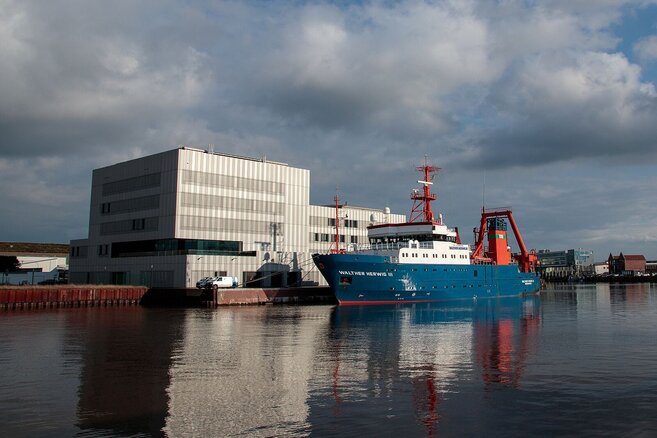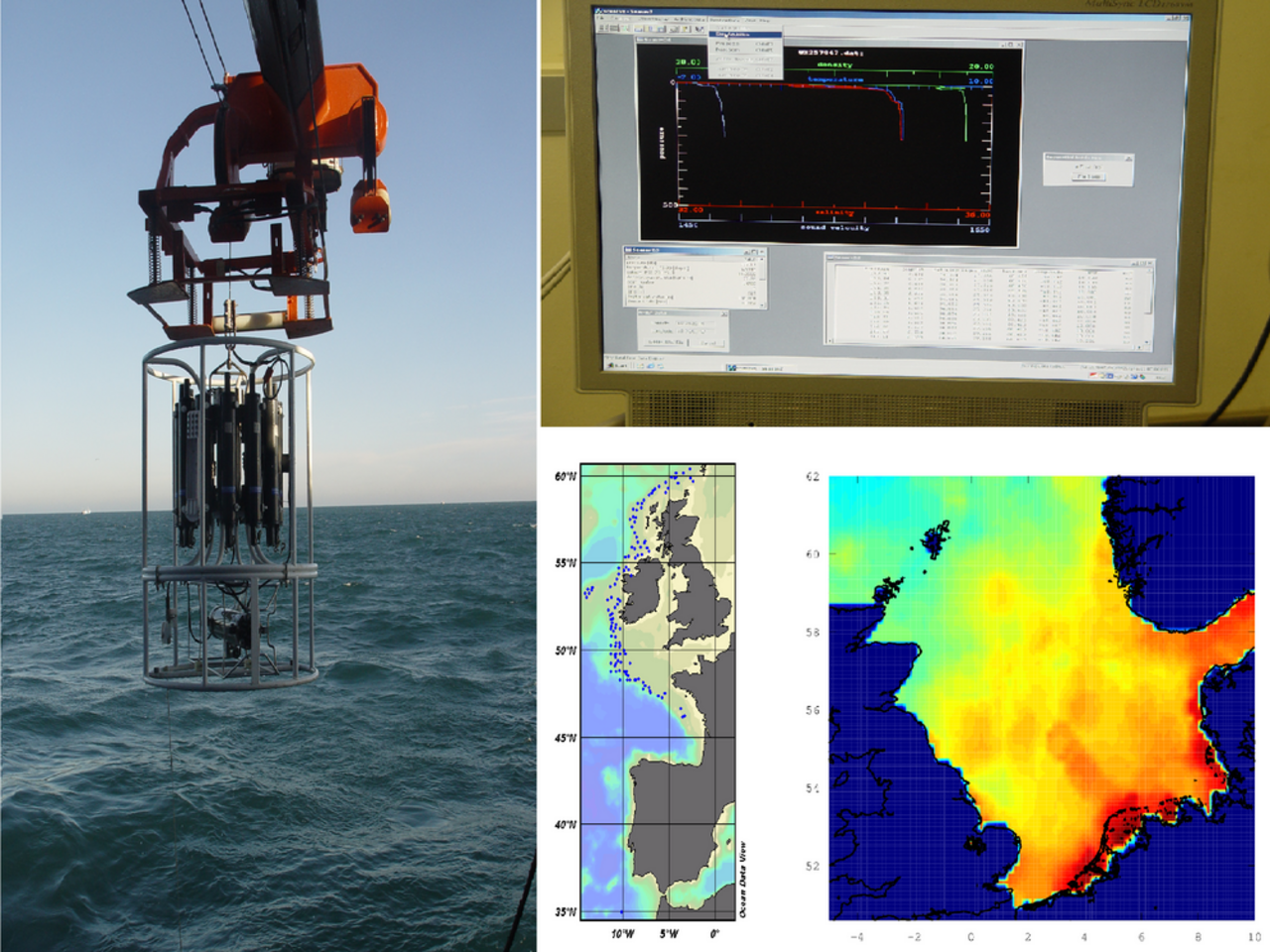

Institut für
SF Seefischerei
Projekt
Biologische Ozeanographie – Wie die Physik die Biologie beeinflusst

Biologische Ozeanographie – Wie die Physik die Biologie beeinflusst
Im Meer beeinflussen Faktoren wie Temperatur, Salinität, Sauerstoff und Strömungen die Umweltbedingungen der Meereslebewesen und haben direkte Auswirkungen auf die marinen Ökosysteme. Wir wollen diese Auswirkungen besser verstehen und quantifizieren, um von klimatischen Trends auf Änderungen in der Biologie zu schließen.
Hintergrund und Zielsetzung
In diesem Projekt erforschen wir den Einfluss der Meeresphysik auf die Fische und Meeresökosysteme. Datenanalysen, statistische Modelle sowie Computersimulationen helfen uns dabei, die komplexen Wechselwirkungen zwischen physikalischen (z.B. Temperatur, Salzgehalt, Strömungsverhältnisse) und biologischen Variablen (z.B. Verteilung der Fischbestände, Biomasse, Rekrutierung) besser zu verstehen und vorherzusagen.
Zielgruppe
Politische Entscheidungsträger; Meereswissenschaftler
Vorgehensweise
Wir nutzen verschiedene statistische Methoden, um die Umwelteinflüsse auf Abundanz, Rekrutierung und Verteilung der kommerziell genutzten Fischarten zu untersuchen. Insbesondere unsere Habitatmodelle sind komplexe statistische Verfahren (generalisierte additive und lineare Modelle) und helfen uns, deterministische Beziehungen zwischen Umwelt und räumlicher Verteilung der Fische zu bestimmen. Diese Modelle ermöglichen, den Einfluss des Klimawandels auf die räumliche Verteilung der Fische zu erforschen sowie mittel- bis langfristige Prognosen der zukünftigen Fischverteilung in Folge des Klimawandels zu berechnen.
Darüber hinaus verwenden wir individuell-basierte Modelle, um die Prozesse zu erforschen, die die Variabilität der Fischrekrutierung steuern. Unsere Modelle simulieren individuelle Fischeier, Larven und ihre Umgebung und schätzen das Wachstum und die Sterblichkeit ein. Die Modelle helfen uns, den möglichen Einfluss von Umwelt- und von Menschen verursachten Veränderungen in Meeresökosystemen (z.B. Offshorewindparks, Küstenschutzmaßnahmen) auf die Überlebenschance von frühen Lebensstadien von Fischen zu untersuchen.
Unsere Forschungsfragen
Welchen Einfluss haben Umweltparameter und Klimaänderungen auf die Verbreitung und Populationsdynamik der nordatlantischen Fischbestände?
Was sind die relevanten Prozesse, und auf welcher räumlichen und zeitlichen Skala treten diese auf?
Thünen-Ansprechperson

Thünen-Beteiligte
Zeitraum
7.2008 - 12.2027
Weitere Projektdaten
Projektstatus:
läuft
Publikationen
- 0
Böer G, Gröger JP, Badri-Höher S, Cisewski B, Renkewitz H, Mittermayer F, Strickmann T, Schramm H (2023) A deep-learning based pipeline for estimating the abundance and size of aquatic organisms in an unconstrained underwater environment from continuously captured stereo video. Sensors 23(6):3311, DOI:10.3390/s23063311
- 1
Moyano M, Illing B, Akimova A, Alter K, Bartolino V, Börner G, Clemmesen C, Finke A, Gröhsler T, Kotterba P, Livdane L, Mittermayer F, Moll D, Nordheim L von, Peck M, Schaber M, Polte P (2023) Caught in the middle: bottom-up and top-down processes impacting recruitment in a small pelagic fish. Rev Fish Biol Fisheries 33(1):55-84, DOI:10.1007/s11160-022-09739-2
- 2
Hodapp D, Roca IT, Fiorentino D, Garilao C, Kaschner K, Kesner-Reyes K, Schneider B, SegschneideJ, Kocsis AT, Kiessling W, Brey T, Froese R (2023) Climate change disrupts core habitats of marine species. Global Change Biol 29(12):3304-3317, DOI:10.1111/gcb.16612
- 3
Akimova A, Peck M, Börner G, Damme CJG van, Moyano M (2023) Combining modeling with novel field observations yields new insights into wintertime food limitation of larval fish. Limnol Oceanogr 68(8):1865-1879, DOI:10.1002/lno.12391
- 4
Núñez-Riboni I, Costas G, Diekmann R, Ulleweit J, Kloppmann MHF (2023) Reviewing and improving spatiotemporal modeling approaches for mackerel's total annual egg production. Rev Fish Biol Fisheries 33(4):1523-1546, DOI:10.1007/s11160-023-09795-2
- 5
Koul V, Brune S, Akimova A, Düsterhus A, Pieper P, Hövel L, Parekh A, Schrum C, Baehr J (2023) Seasonal prediction of Arabian Sea marine heatwaves. Geophys Res Lett 50(18):e2023GL103975, DOI:10.1029/2023GL103975
- 6
Núñez-Riboni I, Chelton DB, Marconi V (2023) The spectral color of natural and anthropogenic time series and its impact on the statistical significance of cross correlation. Sci Total Environ 860:160219, DOI:10.1016/j.scitotenv.2022.160219
- 7
Akimova A, Peck M, Börner G, Damme CJG van, Moyano M (2023) Wintertime growth limitation of herring larvae: combining physiological modelling with novel zooplankton observations. STAGES : Early Life History Section Newsl 44(3):8-9
- 8
Skogen MD, Ji R, Akimova A, Daewel U, Hansen C, Hjollo SS, Leeuwen SM van, Maar M, Macias D, Askov Mousing E, Almroth-Rosell E, Sailley SF, Spence M, Troost TA, van de Wolfshaar K (2021) Disclosing the truth: Are models better than observations? Mar Ecol Progr Ser 680:7-13, DOI:10.3354/meps13574
- 9
Núñez-Riboni I, Akimova A, Sell AF (2021) Effect of data spatial scale on the performance of fish habitat models. Fish Fisheries 22(5):955-973, DOI:10.1111/faf.12563
- 10
Post SL, Werner K-M, Núñez-Riboni I, Chafik L, Hatun H, Jansen T (2021) Subpolar gyre and temperature drive boreal fish abundance in Greenland waters. Fish Fisheries 22(1):161-174, DOI:10.1111/faf.12512
- 11
Taylor MH, Akimova A, Bracher A, Kempf A, Kühn B, Helaouet P (2021) Using dynamic ocean color provinces to elucidate drivers of North Sea hydrography and ecology. JGR Oceans 126(12):e2021JC017686, DOI:10.1029/2021JC017686
- 12
Cisewski B, Hatun H, Kristiansen I, Hansen B, Larsen KMH, Eliasen SK, Jacobsen JA (2021) Vertical migration of pelagic and mesopelagic scatterers from ADCP backscatter data in the Southern Norwegian Sea. Front Mar Sci 7:542386, DOI:10.3389/fmars.2020.542386
- 13
Emblemsvag M, Núñez-Riboni I, Christensen HT, Nogueira A, Gundersen AC, Primicerio R (2020) Increasing temperatures, diversity loss and reorganization of deep-sea fish communities east of Greenland. Mar Ecol Progr Ser 654:127-141, DOI:10.3354/meps13495
- 14
Püts M, Taylor MH, Núñez-Riboni I, Steenbeek J, Stäbler M, Möllmann C, Kempf A (2020) Insights on integrating habitat preferences in process-oriented ecological models - a case study of the southern North Sea. Ecol Model 431:109189, DOI:10.1016/j.ecolmodel.2020.109189
- 15
Núñez-Riboni I, Taylor MH, Kempf A, Püts M, Mathis M (2019) Spatially resolved past and projected changes of the suitable thermal habitat of North Sea cod (Gadus morhua) under climate change. ICES J Mar Sci 76(7):2389-2403, DOI:10.1093/icesjms/fsz132
- 16
Akimova A, Hufnagl M, Peck M (2019) Spatiotemporal dynamics of predators and survival of marine fish early life stages: Atlantic cod (Gadus morhua) in the North Sea. Progr Oceanogr 176:102121, DOI:10.1016/j.pocean.2019.102121
- 17
Beyraghdar Kashkooli O, Gröger JP, Núñez-Riboni I (2017) Qualitative assessment of climate-driven ecological shifts in the Caspian Sea. PLoS One 12(5):e0176892, DOI:10.1371/journal.pone.0176892
- 18
Núñez-Riboni I, Akimova A (2017) Quantifying the impact of the major driving mechanisms of inter-annual variability of salinity in the North Sea. Progr Oceanogr 154:25-37, DOI:10.1016/j.pocean.2017.04.004
- 19
Cisewski B, Strass VH (2016) Acoustic insights into the zooplankton dynamics of the eastern Weddell Sea. Progr Oceanogr 144:42-92, DOI:10.1016/j.pocean.2016.03.005
- 20
Akimova A, Hufnagl M, Kreus M, Peck M (2016) Modeling the effects of temperature on the survival and growth of North Sea cod (Gadus morhua) through the first year of life. Fisheries Oceanogr 25(3):193-209, DOI:10.1111/fog.12145
- 21
Akimova A, Núñez-Riboni I, Kempf A, Taylor MH (2016) Spatially-resolved influence of temperature and salinity on stock and recruitment variability of commercially important fishes in the North Sea. PLoS One 11(9):e0161917, DOI:10.1371/journal.pone.0161917
- 22
Núñez-Riboni I, Akimova A (2015) Monthly maps of optimally interpolated in situ hydrography in the North Sea from 1948 to 2013. J Mar Syst 151:15-34, DOI:10.1016/j.jmarsys.2015.06.003
- 23
Núñez-Riboni I, Kristinsson K, Bernreuther M, Aken HM van, Stransky C, Cisewski B, Rolskiy A (2013) Impact of interannual changes of large scale circulation and hydrography on the spatial distribution of beaked redfish (Sebastes mentella) in the Irminger Sea. Deep Sea Res Pt 1 Oceanogr Res Paper 82:80-94, DOI:10.1016/j.dsr.2013.08.003

